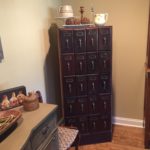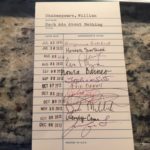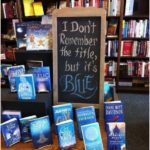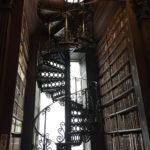I have a relic in the corner of my dining room, a dinosaur that I often have to explain to younger visitors. They mistake it for a toolbox or curious storage cabinet. “This,” I say, running my hand across the rectangular drawers, “is a card catalog. It’s how we used to keep track  of books in the library. Kind of a prehistoric internet.”
of books in the library. Kind of a prehistoric internet.”
I get it, when the young ones digest this information with puzzled expressions. Now that information is a click away on a glowing screen, when Wikipedia does all the heavy lifting, a bank of file drawers with titles, authors, and subjects typed by hand on index cards seems archaic, like an abacus, or 8-track, or jello mold.
As soon as I was old enough to pedal my bike without training wheels, I headed for our local public library. My mother helped me get a library card, an official laminated square with my very own name on it that magically gave me free access to shelf upon shelf of books. When the librarian asked to see my card at the check-out counter, I slid it across to her like it was an American Express on Rodeo Drive. That card was my sole reason for owning a wallet.
It was my impossible goal one summer to read every book in the children’s section. I got mostly through the A’s before realizing there was juicier fodder in the card catalog. I loved the crinkly plastic jacket covers. I loved the pocket stuck to the back cover that held a card stamped with dates tracing the number of times this book or that one had been selected, borrowed, and returned again.
Then, privacy wasn’t such an issue, and the card bore the names of past readers, their signatures a witness to their interest in a given topic on a given day. The names on those cards used to fill me with stories of the imagined lives of the borr owers. Why did Alice Dodd renew Sounder three times? Was her life so hectic she couldn’t finish it or did she just like a good cry? What kind of a person was Mark Amos that drew him to read Sylvia Plath? I always felt sorry for the books with blank or sparse check-out histories. If I found one, I’d renew it just to give it an extra stamp.
owers. Why did Alice Dodd renew Sounder three times? Was her life so hectic she couldn’t finish it or did she just like a good cry? What kind of a person was Mark Amos that drew him to read Sylvia Plath? I always felt sorry for the books with blank or sparse check-out histories. If I found one, I’d renew it just to give it an extra stamp.
High school research papers forced me to the library for business, not pleasure. I gained  new respect for librarians: the Fairy Godmothers of Knowledge. No topic was too vague or obscure for them. A few flips through the card catalog and they could unearth the holy grail itself. I honed my hand-eye coordination by operating the microfiche machine in a dim-lit room, scrolling through old newspapers to find material. Librarians will run heaven’s registrar office. You will be able to cross the pearly gates after a nasty bump on the head with no idea who you are. They will peer down at you, size up that scar on your left knee and the slightly upturned nose, flip through a dusty tome or two and recite your ancestry, character flaws and deeds of note leaving plenty of time for lunch.
new respect for librarians: the Fairy Godmothers of Knowledge. No topic was too vague or obscure for them. A few flips through the card catalog and they could unearth the holy grail itself. I honed my hand-eye coordination by operating the microfiche machine in a dim-lit room, scrolling through old newspapers to find material. Librarians will run heaven’s registrar office. You will be able to cross the pearly gates after a nasty bump on the head with no idea who you are. They will peer down at you, size up that scar on your left knee and the slightly upturned nose, flip through a dusty tome or two and recite your ancestry, character flaws and deeds of note leaving plenty of time for lunch.
Libraries exert no pressure. Unlike bookstores, where I feel as if I must carry around a book or two to give the appearance of being a potential purchaser, libraries are for loafing. Borrow it, or don’t. Read the whole thing in the chair by the window and they won’t cast disapproving looks at you because they’ve lost a sale. If they don’t have it, someone else in the world wide library family probably does, and they’ll send it over! Even their overdue fees are ridiculous! Ten cents a day? No other civic institution operates on these sort of fumes. Libraries are the best game in town. They don’t play favorites. Anyone can come to story time, have access to reading, and take home a stack of books to explore. They give out library cards like Halloween candy.
Some of the most beautiful places in the world are libraries. We stopped in Dublin’s Trinity College Library this past summer for a glimpse at the famous Book of Kells. This was one of the most beautiful books in the world housed in one of the most beautiful libraries in the world. When we left after our tour, my husband and I were both pretty much like this:
![]()
Seriously, floor to ceiling leather-bound volumes with gilt edges. An arched wooden ceiling with a spiral iron staircase leading to the topmost stacks.  Golden letters on the shelves to alphabetize by author. Unfortunately, they weren’t keen on a couple of American tourists becoming “Readers in Residence,” despite our offer.
Golden letters on the shelves to alphabetize by author. Unfortunately, they weren’t keen on a couple of American tourists becoming “Readers in Residence,” despite our offer.
Because libraries often rely on donations and limited acquisition budgets, they tend to keep books around a long time. The more ancient and historical libraries are literal repositories for the history of the world. As Virginia Woolf said, “I ransack public libraries, and find them full of sunk treasure.” Indeed.
Plus, when you reach a “certain age,” they’re one of the only places where you’re still going to get carded. Free books and an ego-boost: who can’t use more of those?









Aaaahh I want that card catalog! *goes trolling antique stores* And I loved reading all the names on a library checkout card, wondering if I knew anyone (the branch of the library I frequented as a kid was hyper-local, serving a very small area).
Be still my beating heart! Oh, your card catalog–what a find. Great read.
I’m glad you commented on my post – it made me wonder if I had commented on yours. I remembered clicking on it, but must have gotten pulled away by a cat, or something, and never finished reading it. I’m so glad I came back! 🙂 A fun and informative post!
I used to be a calligrapher and I would love to see the Book of Kells! There is a now hand lettered and illuminated bible in the US done in the 1990s by a team of top calligraphers from around the world. It’s at St. John’s Abbey and University in Collegeville, MN. https://www.saintjohnsbible.org.
I’m hoping to get to see it as I once took workshops from many of the calligraphers at a conference at St. John’s.
Beautiful! I especially love the gold leafing. I look at things like that and all I can think is PATIENCE! Patience and good lighting. 🙂
Wow I love that old card catalogue cabinet. Beautiful! 🙂 Great post
Oh! I love this! Seeing the book of Kells and Dublin’s Trinity College Library was one of my favorite adventures. I wanted to stay and read all the books too! It was absolutely breathtaking–and now I want to go back. I’ll probably save the plane fare and check out an armload of books from my (also beautiful) local library instead. 🙂
Gorgeous, gorgeous, gorgeous. I love this post.
“…subjects typed by hand on index cards seems archaic, like an abacus, or 8-track, or jello mold.”
“When the librarian asked to see my card at the check-out counter, I slid it across to her like it was an American Express on Rodeo Drive. That card was my sole reason for owning a wallet.”
“Libraries exert no pressure. Unlike bookstores, where I feel as if I must carry around a book or two to give the appearance of being a potential purchaser, libraries are for loafing. Borrow it, or don’t. Read the whole thing in the chair by the window and they won’t cast disapproving looks at you because they’ve lost a sale.”
“What kind of a person was Mark Amos that drew him to read Sylvia Plath?”
Thank you, Julie! It’s always fun to “hop” at the end of each month!
Oh that must have been a thrill to see The Book of Kells! And I love that picture “..but it’s blue”. True keepers of knowledge.